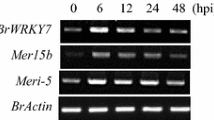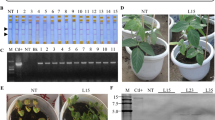Abstract
Pectobacterium carotovorum subsp. carotovorum causes soft rot disease in various plants, including Chinese cabbage. The simple extracellular leucine-rich repeat (eLRR) domain proteins have been implicated in disease resistance. Rice leucine-rich repeat protein (OsLRP), a rice simple eLRR domain protein, is induced by pathogens, phytohormones, and salt. To see whether OsLRP enhances disease resistance to bacterial soft rot, OsLRP was introduced into Chinese cabbage by Agrobacterium-mediated transformation. Two independent transgenic lines over-expressing OsLRP were generated and further analyzed. Transgenic lines over-expressing OsLRP showed enhanced disease resistance to bacterial soft rot compared to non-transgenic control. Bacterial growth was retarded in transgenic lines over-expressing OsLRP compared to non-transgenic controls. We propose that OsLRP confers enhanced resistance to bacterial soft rot. Monitoring expression of defense-associated genes in transgenic lines over-expressing OsLRP, two different glucanases and Brassica rapa polygalacturonase inhibiting protein 2, PDF1 were constitutively activated in transgenic lines compared to non-transgenic control. Taken together, heterologous expression of OsLRP results in the activation of defense response and enhanced resistance to bacterial soft rot.




Similar content being viewed by others
Abbreviations
- OsLRP:
-
Oryza sativa leucine-rich repeat protein
- Pcc:
-
Pectobacterium carotovorum subsp. carotovorum
- HR:
-
Hypersensitive response
- HIR:
-
Hypersensitive-induced reaction
- Xoo:
-
Xanthomonas oryzae pv. oryzae
References
Ban H, Chai X, Lin Y, Zhou Y, Peng D, Zhou Yi, Zou Y, Yu Z, Sun M (2009) Transgenic Amorphophallus konjac expressing synthesized acyl-homoserine lactonase (aiiA) gene exhibit enhanced resistance to soft rot disease. Plant Cell Rep 28:1847–1855
Hipskind JD, Nicholson RL, Goldsbrough PB (1996) Isolation of a cDNA encoding a novelleucine-rich repeat motif from Sorghum bicolor inoculated with fungi. Mol Plant Microbe Interact 9(9):819–825
Hwang SH, Lee IA, Yie SW, Hwang DJ (2008) Identification of an OsPR10a promoter region responsive to salicylic acid. Planta 227(5):1141–1150
Hwang BH, Bae H, Lim HS, Kim K, Kim S, Im MH, Park BS, Kim D, Kim J (2010) Overexpression of polygalacturonase-inhibiting protein 2 (PGIP2) of Chinese cabbage (Brassica rapa ssp. pekinensis) increased resistance to the bacterial pathogen Pectobacterium carotovorum ssp. carotovorum. Plant Cell Tiss Organ Cult 103:293–305
Hwang SH, Yie SW, Hwang DJ (2011) Heterologous expression of OsWRKY6 gene in Arabidopsis activates the expression of defense related genes and enhances resistance to pathogens. Plant Sci 181:316–323
Jacques A, Ghannam A, Erhardt M, de Ruffray P, Baillieul F, Kauffmann S (2006) NtLRP1, a tobacco leucine-rich repeat gene with a possible role as a modulator of the hypersensitive response. MPMI 19(7):747–757
Ji GH, Wei LF, He YQ, Wu YP, Bai XH (2008) Biological control of rice bacterial blight by Lysobacter antibioticus strain 13–1. Biol Control 45(3):286–296
Jung HW, Hwang BK (2007) The leucine-rich repeat (LRR) protein, CaLRR1, interacts with the hypersensitive induced reaction (HIR) protein, CaHIR1, and suppresses cell death induced by the CaHIR1 protein. Mol Plant Pathol 8(4):503–514
Jung EH, Jung HW, Lee SC, Han SW, Heu S, Hwang BK (2004) Identification of a novel pathogen-induced gene encoding a leucine-rich repeat protein expressed in phloem cells of Capsicum annuum. Biochim Biophys Acta 1676(3):211–222
Jung YJ, Choi CS, Park JH, Kang HW, Choi JE, Nou IS, Lee SY (2008) Overexpression of the pineapple fruit bromelain gene (BAA) in transgenic Chinese cabbage (Brassica rapa) results in enhanced resistance to bacterial soft rot. Electron J Biotechnol 11:1–8
Lacomme C, Dominique R (1999) Identification of new early markers of the hypersensitive response in Arabidopsis thaliana. FEBS 459(1999):149–153
Lam E, Kato N, Lawton M (2001) Programmed cell death, mitochondria and the plant hypersensitive response. Nature 411:848–853
Lee IA (2005) Isolation and characterization of auxin-regulated gene (BcAXR1) from Chinese cabbage (Brassica campestris). Unpublished thesis (M.A.), The Catholic University of Korea
Liau CH, Lu JC, Prasad V, Hsiao H, You SJ, Lee J, Yang NS, Huang HE, Feng TY, Chen WH, Chan MT (2003) The sweet pepper ferredoxin-like protein (pflp) conferred resistance against soft rot disease in Oncidium orchid. Transgenic Res 12:329–336
Pandey AK, Ger MJ, Huang HE, Yip MK, Zeng J, Feng TY (2005) Expression of the hypersensitive response-assisting protein in Arabidopsis results in harpin-dependent hypersensitive cell death in response to Erwinia carotovora. Plant Mol Biol 59:771–780
Ren JP, Petzoldt R, Dickson MH (2001) Screening and identification of resistance to bacterial soft rot in Brassica rapa. Euphytica 118:271–280
Tornero P, Mayda E, Gómez MD, Cañas L, Conejero V, Vera P (1996) Characterization of LRP, a leucine-rich repeat (LRR) protein from tomato plants that is processed during pathogenesis. Plant J 10(2):315–330
van der Hoorn RA, Wulff BB, Rivas S, Durrant MC, van der Ploeg A, de Wit PJ, Jones JD (2005) Structure–function analysis of Cf-9, a receptor-like protein with extracytoplasmic leucine-rich repeats. Plant Cell 17(3):1000–1015
Vanjildorj E, Song SY, Yang ZH, Choi JE, Noh YS, Park S, Lim WJ, Cho KM, Yun HD, Lim YP (2009) Enhancement of tolerance to soft rot disease in the transgenic Chinese cabbage (Brassica rapa L. ssp. Pekinensis) inbred line Kenshin. Plant Cell Rep 28:1581–1591
Vlot AC, Klessig DF, Park SW (2008) Systemic acquired resistance: the elusive signal(s). Curr Opin Plant Biol 11:436–442
Zhou L, Cheung MY, Zhang Q, Lei CL, Zhang SH, Sun SS, Lam HM (2009) A novel simple extracellular leucine-rich repeat (eLRR) domain protein from rice (OsLRR1) enters the endosomal pathway and interacts with the hypersensitive-induced reaction protein 1 (OsHIR1). Plant Cell Environ 32(12):1804–1820
Zhou L, Cheung MY, Li MW, Fu Y, Sun Z, Sun SM, Lam HM (2010) Rice hypersensitive induced reaction protein 1 (OsHIR1) associates with plasma membrane and triggers hypersensitive cell death. BMC Plant Biol 10:290–299
Acknowledgments
This work was supported in part by two Grants (PJ007850 and PJ008574) from Rural Development Administration (RDA) to Duk-Ju Hwang.
Author information
Authors and Affiliations
Corresponding author
Additional information
Communicated by J. S. Shin.
Y.H. Park and C. Choi contributed equally to this work.
Rights and permissions
About this article
Cite this article
Park, Y.H., Choi, C., Park, E.M. et al. Over-expression of rice leucine-rich repeat protein results in activation of defense response, thereby enhancing resistance to bacterial soft rot in Chinese cabbage. Plant Cell Rep 31, 1845–1850 (2012). https://doi.org/10.1007/s00299-012-1298-9
Received:
Revised:
Accepted:
Published:
Issue Date:
DOI: https://doi.org/10.1007/s00299-012-1298-9




